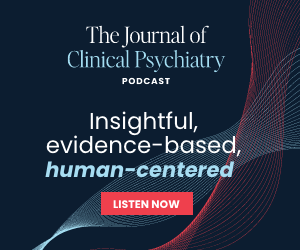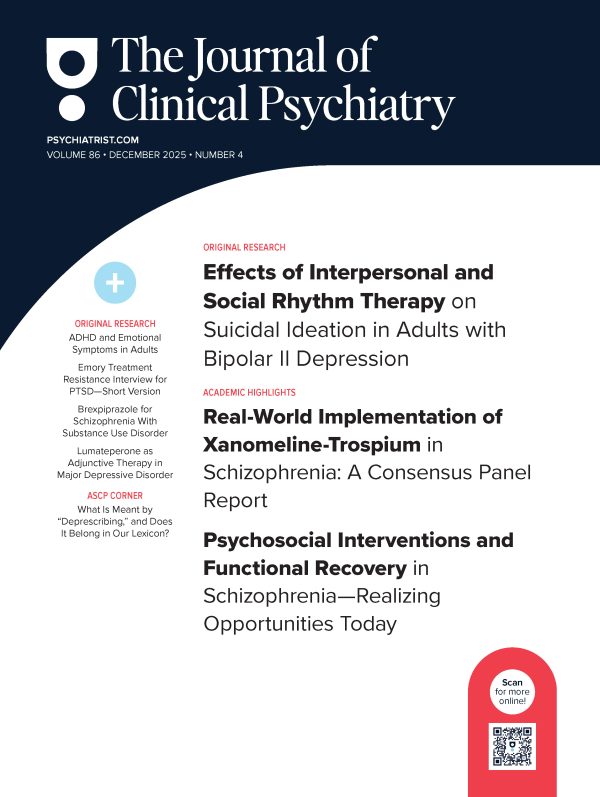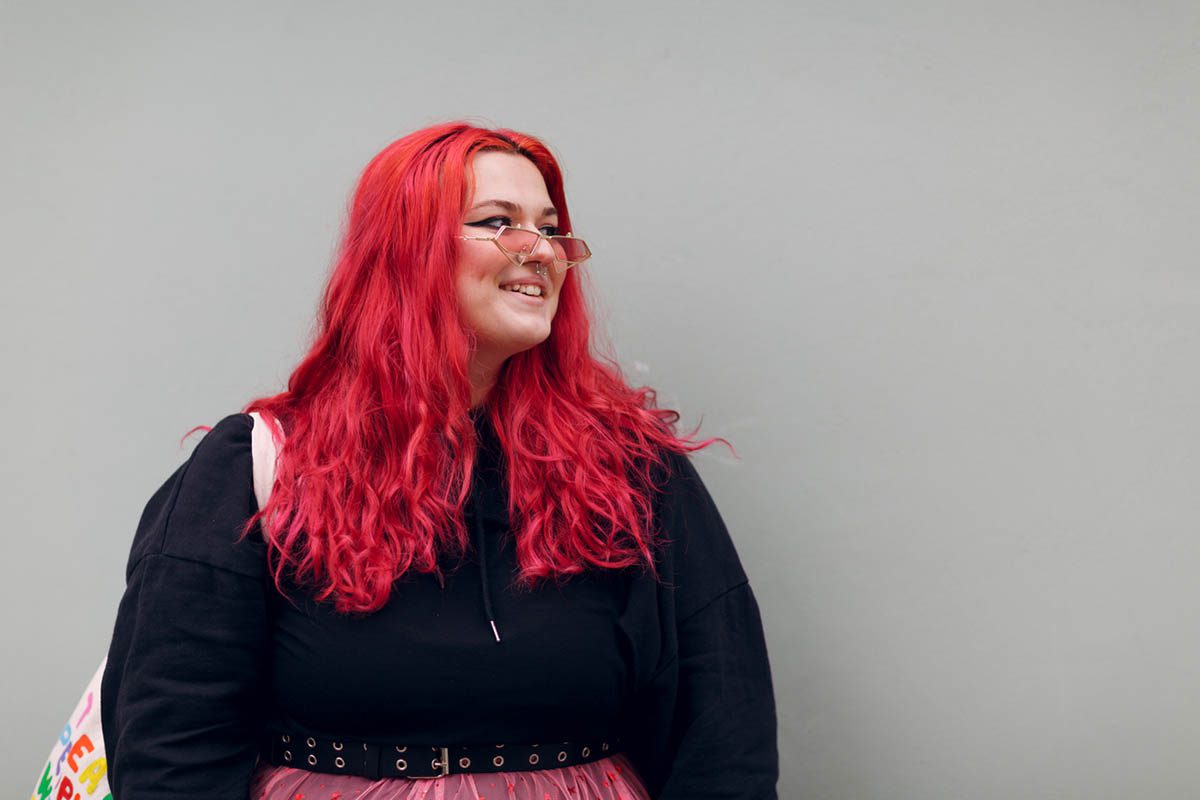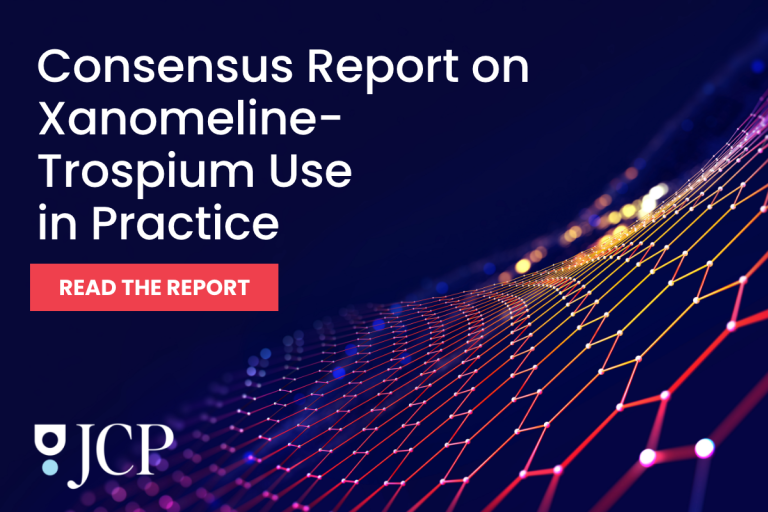
ABSTRACT
Background: Treatment resistance is a significant problem among young people experiencing moderate-to-severe anxiety, affecting nearly half of all patients. This study investigated the safety and efficacy of cannabidiol (CBD), a non-intoxicating component of Cannabis sativa, for anxiety disorders in young people who previously failed to respond to standard treatment.
Methods: In this open-label trial, 31 young people aged 12–25 years with a DSM-5 anxiety disorder and no clinical improvement despite treatment with cognitive-behavioral therapy and/or antidepressant medication were enrolled between May 16, 2018, and June 28, 2019. All participants received add-on CBD for 12 weeks on a fixed-flexible schedule titrated up to 800 mg/d. The primary outcome was improvement in anxiety severity, measured with the Overall Anxiety Severity and Impairment Scale (OASIS), at week 12. Secondary outcomes included comorbid depressive symptoms, Clinical Global Impressions scale (CGI) score, and social and occupational functioning.
Results: Mean (SD) OASIS scores decreased from 10.8 (3.8) at baseline to 6.3 (4.5) at week 12, corresponding to a −42.6% reduction (P < .0001). Depressive symptoms (P < .0001), CGI-Severity scale scores (P = .0008), and functioning (P = .04) improved significantly. Adverse events were reported in 25 (80.6%) of 31 participants and included fatigue, low mood, and hot flushes or cold chills. There were no serious and/or unexpected adverse events.
Conclusions: These findings suggest that CBD can reduce anxiety severity and has an adequate safety profile in young people with treatment-resistant anxiety disorders. Randomized controlled trials are needed to confirm the efficacy and longer-term safety of this compound.
Trial Registration: New Zealand Clinical Trials Registry (ANZCTR) identifier: ACTRN12617000825358
Members Only Content
This full article is available exclusively to Professional tier members. Subscribe now to unlock the HTML version and gain unlimited access to our entire library plus all PDFs. If you’re already a subscriber, please log in below to continue reading.
References (43)

- Beesdo K, Knappe S, Pine DS. Anxiety and anxiety disorders in children and adolescents: developmental issues and implications for DSM-V. Psychiatr Clin North Am. 2009;32(3):483–524. PubMed CrossRef
- Ginsburg GS, Becker EM, Keeton CP, et al. Naturalistic follow-up of youths treated for pediatric anxiety disorders. JAMA Psychiatry. 2014;71(3):310–318. PubMed CrossRef
- Kessler RC, Ruscio AM, Shear K, et al. Epidemiology of anxiety disorders. Curr Top Behav Neurosci. 2010;2:21–35. PubMed CrossRef
- Copeland WE, Angold A, Shanahan L, et al. Longitudinal patterns of anxiety from childhood to adulthood: the Great Smoky Mountains Study. J Am Acad Child Adolesc Psychiatry. 2014;53(1):21–33. PubMed CrossRef
- Cuijpers P, Cristea IA, Karyotaki E, et al. How effective are cognitive behavior therapies for major depression and anxiety disorders? A meta-analytic update of the evidence. World Psychiatry. 2016;15(3):245–258. PubMed CrossRef
- James AC, James G, Cowdrey FA, et al. Cognitive behavioural therapy for anxiety disorders in children and adolescents. Cochrane Database Syst Rev. 2015;(2):CD004690. PubMed
- Strawn JR, Welge JA, Wehry AM, et al. Efficacy and tolerability of antidepressants in pediatric anxiety disorders: a systematic review and meta-analysis. Depress Anxiety. 2015;32(3):149–157. PubMed CrossRef
- Baldwin D, Woods R, Lawson R, et al. Efficacy of drug treatments for generalised anxiety disorder: systematic review and meta-analysis. BMJ. 2011;342(mar11 1):d1199. PubMed CrossRef
- Dobson ET, Bloch MH, Strawn JR. Efficacy and tolerability of pharmacotherapy for pediatric anxiety disorders: a network meta-analysis. J Clin Psychiatry. 2019;80(1):17r12064. PubMed CrossRef
- Bhattacharyya S, Morrison PD, Fusar-Poli P, et al. Opposite effects of delta-9-tetrahydrocannabinol and cannabidiol on human brain function and psychopathology. Neuropsychopharmacology. 2010;35(3):764–774. PubMed CrossRef
- Blessing EM, Steenkamp MM, Manzanares J, et al. Cannabidiol as a potential treatment for anxiety disorders. Neurotherapeutics. 2015;12(4):825–836. PubMed CrossRef
- Chesney E, Oliver D, Green A, et al. Adverse effects of cannabidiol: a systematic review and meta-analysis of randomized clinical trials. Neuropsychopharmacology. 2020;45(11):1799–1806. PubMed CrossRef
- McGuire P, Robson P, Cubala WJ, et al. Cannabidiol (CBD) as an adjunctive therapy in schizophrenia: a multicenter randomized controlled trial. Am J Psychiatry. 2018;175(3):225–231. PubMed CrossRef
- Leweke FM, Piomelli D, Pahlisch F, et al. Cannabidiol enhances anandamide signaling and alleviates psychotic symptoms of schizophrenia. Transl Psychiatry. 2012;2(3):e94. PubMed CrossRef
- Devinsky O, Cross JH, Laux L, et al; Cannabidiol in Dravet Syndrome Study Group. Trial of cannabidiol for drug-resistant seizures in the Dravet Syndrome. N Engl J Med. 2017;376(21):2011–2020. PubMed CrossRef
- Devinsky O, Marsh E, Friedman D, et al. Cannabidiol in patients with treatment-resistant epilepsy: an open-label interventional trial. Lancet Neurol. 2016;15(3):270–278. PubMed CrossRef
- Black N, Stockings E, Campbell G, et al. Cannabinoids for the treatment of mental disorders and symptoms of mental disorders: a systematic review and meta-analysis. Lancet Psychiatry. 2019;6(12):995–1010. PubMed CrossRef
- Klier CM, de Gier C, Felnhofer A, et al. A case report of cannabidiol treatment of a Crohn’s disease patient with anxiety disorder. J Clin Psychopharmacol. 2020;40(1):90–92. PubMed CrossRef
- Shannon S, Lewis N, Lee H, et al. Cannabidiol in Anxiety and Sleep: A Large Case Series. Permanente J.; 2019:23.
- Shannon S, Opila-Lehman J. Effectiveness of cannabidiol oil for pediatric anxiety and insomnia as part of posttraumatic stress disorder: a case report. Perm J. 2016;20(4):16–005. PubMed CrossRef
- Crippa JA, Derenusson GN, Ferrari TB, et al. Neural basis of anxiolytic effects of cannabidiol (CBD) in generalized social anxiety disorder: a preliminary report. J Psychopharmacol. 2011;25(1):121–130. PubMed CrossRef
- Bergamaschi MM, Queiroz RH, Chagas MH, et al. Cannabidiol reduces the anxiety induced by simulated public speaking in treatment-naïve social phobia patients. Neuropsychopharmacology. 2011;36(6):1219–1226. PubMed CrossRef
- Masataka N. Anxiolytic effects of repeated cannabidiol treatment in teenagers with social anxiety disorders. Front Psychol. 2019;10:2466. PubMed CrossRef
- McGorry PD, Goldstone SD, Parker AG, et al. Cultures for mental health care of young people: an Australian blueprint for reform. Lancet Psychiatry. 2014;1(7):559–568. PubMed CrossRef
- Headspace Australia. Annual Report 2019–2020; 2020.
- Anderson LL, Doohan PT, Oldfield L, et al. Citalopram and cannabidiol: in vitro and in vivo evidence of pharmacokinetic interactions relevant to the treatment of anxiety disorders in young people. J Clin Psychopharmacol. 2021;41(5):525–533. PubMed CrossRef
- Kevin RC, Vogel R, Doohan P, et al. A validated method for the simultaneous quantification of CBD, THC, and their metabolites in human plasma, and application to plasma samples from an oral CBD open label trial. Drug Test Anal. 2021;13(3):614–627. PubMed CrossRef
- Norman SB, Campbell-Sills L, Hitchcock CA, et al. Psychometrics of a brief measure of anxiety to detect severity and impairment: the Overall Anxiety Severity and Impairment Scale (OASIS). J Psychiatr Res. 2011;45(2):262–268. PubMed CrossRef
- Norman SB, Cissell SH, Means-Christensen AJ, et al. Development and validation of an Overall Anxiety Severity and Impairment Scale (OASIS). Depress Anxiety. 2006;23(4):245–249. PubMed CrossRef
- Moore SA, Welch SS, Michonski J, et al. Psychometric evaluation of the Overall Anxiety Severity And Impairment Scale (OASIS) in individuals seeking outpatient specialty treatment for anxiety-related disorders. J Affect Disord. 2015;175:463–470. PubMed CrossRef
- American Psychiatric Association. Diagnostic and Statistical Manual for Mental Disorders. Fifth Edition. Washington, DC: 2013.
- Guy W. ECDEU Assessment Manual for Psychopharmacology. US Department of Health, Education, and Welfare, Public Health Service, Alcohol, Drug Abuse, and Mental Health Administration, National Institute of Mental Health, Psychopharmacology Research Branch, Division of Extramural Research Programs; 1976.
- Hamilton M. The assessment of anxiety states by rating. Br J Med Psychol. 1959;32(1):50–55. PubMed CrossRef
- Rush AJ, Trivedi MH, Ibrahim HM, et al. The 16-Item Quick Inventory of Depressive Symptomatology (QIDS), clinician rating (QIDS-C), and self-report (QIDS-SR): a psychometric evaluation in patients with chronic major depression. Biol Psychiatry. 2003;54(5):573–583. PubMed CrossRef
- Morosini PL, Magliano L, Brambilla L, et al. Development, reliability and acceptability of a new version of the DSM-IV Social and Occupational Functioning Assessment Scale (SOFAS) to assess routine social functioning. Acta Psychiatr Scand. 2000;101(4):323–329. PubMed CrossRef
- Allsop DJ, Norberg MM, Copeland J, et al. The Cannabis Withdrawal Scale development: patterns and predictors of cannabis withdrawal and distress. Drug Alcohol Depend. 2011;119(1–2):123–129. PubMed CrossRef
- Gulbransen G, Xu W, Arroll B. Cannabidiol prescription in clinical practice: an audit on the first 400 patients in New Zealand. BJGP Open. 2020;4(1):bjgpopen20X101010. PubMed CrossRef
- Russo EB, Burnett A, Hall B, et al. Agonistic properties of cannabidiol at 5-HT1a receptors. Neurochem Res. 2005;30(8):1037–1043. PubMed CrossRef
- Amminger GP, Berger M, Rice SM, et al. Novel biotherapies are needed in youth mental health. Australas Psychiatry. 2017;25(2):117–120. PubMed CrossRef
- Iffland K, Grotenhermen F. An update on safety and side effects of cannabidiol: a review of clinical data and relevant animal studies. Cannabis Cannabinoid Res. 2017;2(1):139–154. PubMed CrossRef
- Brown JD, Winterstein AG. Potential adverse drug events and drug-drug interactions with medical and consumer Cannabidiol (CBD) use. J Clin Med. 2019;8(7):989. PubMed CrossRef
- Richelson E. Pharmacokinetic drug interactions of new antidepressants: a review of the effects on the metabolism of other drugs. Mayo Clin Proc. 1997;72(9):835–847. PubMed CrossRef
- Huezo-Diaz P, Perroud N, Spencer EP, et al. CYP2C19 genotype predicts steady state escitalopram concentration in GENDEP. J Psychopharmacol. 2012;26(3):398–407. PubMed CrossRef





